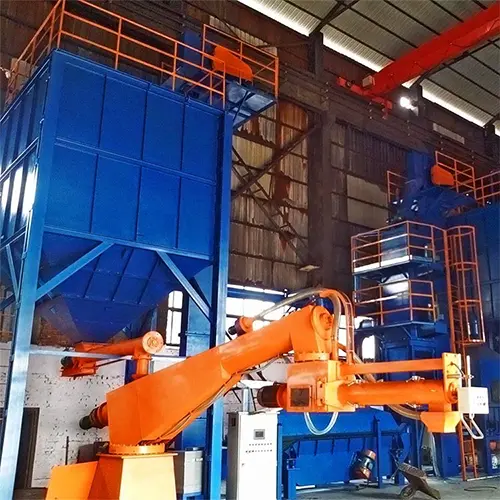Resin sand molding and lost foam casting advantages and disadvantages
1. Resin sand molding process
Advantages:
High precision and surface quality
Resin sand molds have high strength and good dimensional stability, and are suitable for the production of complex, thin-walled or high-precision castings (such as engine blocks, valves, etc.).
The surface finish of the casting is high, reducing the amount of subsequent processing.
Strong adaptability
Applicable to various alloy materials (cast iron, cast steel, aluminum alloy, etc.) and different batch production (single piece, small batch to medium batch).
It can adapt to different process requirements by adjusting the type of resin (such as furan resin, alkaline phenolic resin).
Process flexibility
Sand molds can be hardened quickly (self-hardening or heating curing), shortening the production cycle.
Complex cavities can be made, and the parting surface design is flexible.
Recycling
Old sand can be partially recycled and reused to reduce material costs.
Disadvantages:
High cost
Resins are expensive and need to be combined with curing agents and catalysts. The material cost is significantly higher than that of ordinary clay sand.
Sand regeneration equipment requires large investment, which may be difficult for small enterprises to afford.
Environmental issues
Harmful gases such as formaldehyde and phenol are released during the curing process of resin, and an exhaust gas treatment system is required.
The recycling rate of old sand is limited, and the treatment of waste sand may cause environmental pollution.
Complex process control
Parameters such as the ratio of resin to curing agent, sand mixing time, and temperature need to be strictly controlled, otherwise it is easy to cause insufficient strength or cracking of the sand mold.
2. Lost foam casting process
Advantages:
High design freedom
No parting surface and core are required, and complex inner cavities and special-shaped structural parts (such as pump bodies, manifolds, etc.) can be directly cast.
Model integration reduces assembly errors and improves dimensional accuracy.
Simplified process flow
Omits the steps of demolding and box closing in traditional modeling, shortens the production cycle, and is suitable for mass production.
No sand core is required, reducing process complexity.
High material utilization rate
With no riser design or small riser design, the utilization rate of molten metal can reach more than 90%, reducing waste.
The foam model is light and has low transportation and storage costs.
Good surface quality
The casting surface has no flash or burrs, and the subsequent cleaning workload is small.
Disadvantages:
Model cost and preparation cycle
Foam models require special molds for foaming and molding, which is expensive and has poor economic efficiency in small batch production.
The production cycle of complex models is long, which affects the delivery time.
Risk of pores and defects
The gas produced by foam combustion is easy to form pores and slag inclusions in castings, and the pouring process (such as negative pressure pouring) needs to be strictly controlled.
High requirements for the fluidity and filling capacity of molten metal are prone to defects such as cold shut and insufficient pouring.
Environmental protection and health issues
When the foam decomposes at high temperature, harmful gases such as styrene are released, and efficient dust removal and exhaust gas treatment systems need to be equipped.
Attention should be paid to fire prevention and explosion prevention at the production site.
Limited scope of application
Poor adaptability to thick and large sections or high melting point alloys (such as cast steel), easy to produce carbon defects.
3. Key comparison summary
Comparison items Resin sand molding Lost foam casting
Applicable batch Single piece, small batch to medium batch Medium to large batch (need to amortize mold cost)
Casting complexity High (need parting design) Very high (integrated model)
Surface quality Excellent Good (need to control pores)
Material cost High (resin, curing agent) Medium to high (foam mold)
Environmental pressure High (harmful gas, waste sand) High (gas pollution)
Production cycle Medium (need sand mold curing) Short (quick pouring after model preparation)
Typical applications Machine tool parts, valves, pump bodies Automotive parts, pipe fittings, artistic castings
4. Process selection recommendations
Choose resin sand:
Castings with complex structures and high precision requirements (such as aerospace parts).
Multi-material, small batch production, or frequent changes in product models.
Scenarios with strict requirements on surface quality and mechanical properties.
Choose lost foam:
Mass production of castings with complex structures but moderate weight (such as automobile engine brackets).
Scenarios where machining allowances and metal consumption need to be reduced.
When designs change frequently, quick responses can be made by modifying the foam mold.
V. Future Trends
Resin sand: Develop towards low-pollution resins (such as nitrogen-free resins) and efficient regeneration technologies to reduce environmental pressure.
Lost foam: Combine 3D printing technology to directly manufacture foam models, break through the limitations of traditional molds, and achieve economic efficiency in small batch production.
By comprehensively considering cost, quality, environmental protection and efficiency requirements, the rational selection of processes can significantly enhance the competitiveness of foundry companies.






